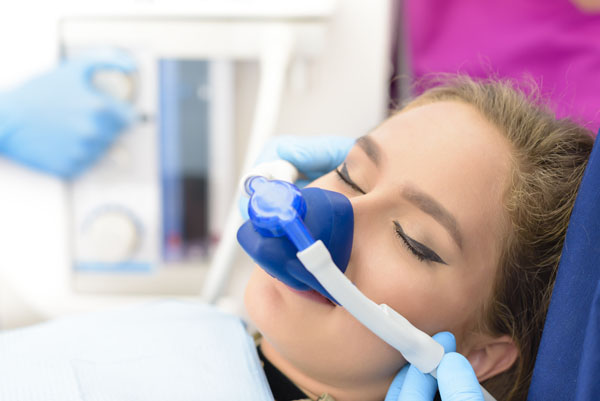SERVICES

DENTAL CLEANINGS AND CONTINUING CARE
We recommend that every member of your family visit the dentist at least twice a year for exams and continuing care with the dental hygienist. These regular visits help reduce incidences of gum disease and tooth decay, which are common oral health problems that can be hard to avoid with brushing and flossing alone.

PERIODONTAL DISEASE TREATMENT
Periodontal diseases are infections of the gums. If allowed to progress without treatment, they gradually destroy the support of your natural teeth. Dental plaque is the primary cause of gum disease. Bacteria found in plaque produce toxins or poisons, which irritate the gums. When your gums become unhealthy, they can either recede or become swollen and red. In later stages, the supporting bone is destroyed and your teeth may shift, loosen, or fall out. These changes affect the appearance of your smile as well as your ability to chew and speak.
We pride ourselves on being very conservative in our treatment recommendations, limiting surgery to the areas where it is absolutely necessary. Many times, the early stages of periodontal disease are best treated with non-surgical periodontal therapy. Even in severe cases, surgical therapy is often preceded by nonsurgical periodontal therapy. This is done to improve the overall tissue quality prior to surgery and also to help limit the areas requiring surgery.

SEDATION WITH NITROUS OXIDE
Do you ever feel nervous about visiting the dentist? Does your upcoming treatment make you feel anxious? If so, you may benefit from nitrous oxide sedation at our office. Nitrous oxide, also known as laughing gas, is a gas that you inhale through a nose mask during your treatment. As you breathe in the nitrous oxide, which is mixed with oxygen, you will experience a relaxed, euphoric sensation. Nitrous oxide can help you feel calm and at ease throughout your treatment. Nitrous oxide sedation is very safe; the effects will wear off within just a few minutes after we remove your nose mask.

TOOTH-COLORED BONDING AND FILLINGS
Bonding refers to tooth-colored restorative material that can be used to treat teeth in many different ways. The bonding material is a resin that strongly adheres to tooth structure and comes in many different shades to match the tooth. Modern bonding materials are long-lasting and blend in so well that they can hardly be detected.
A bonded filling also requires the removal of less tooth structure. Bonding can be used to repair fractured front teeth or in cases where cosmetic improvement is desired. The entire bonding procedure can usually be accomplished in one appointment and in some instances without using any anesthetic.

DENTAL IMPLANTS
Dental implants are tiny titanium posts that are placed into the jawbone where teeth are missing. The bone bonds with the titanium creating a strong anchor for the artificial teeth (crowns). In addition to a repaired dentition, placement of implants can help preserve facial structure by preventing deterioration of the jaw that occurs when teeth are missing. After placement of a dental implant, a crown is placed on the implant by the patient’s restorative dentist, giving the patient a tooth replacement. Placement of an implant requires adequate bone and gum tissue for the best possible aesthetic result.

PORCELAIN CROWNS
Crowns look and function just like natural teeth. A crown may be recommended if your tooth has enough decay that it cannot hold a filling, or if your tooth is cracked or broken and in danger of fracturing into the root if left unattended. Placing a crown on a compromised tooth will restore its strength, and prevent unnecessary tooth loss and/or expense. A crown covers your tooth completely and fits snugly at the gum to protect what remains of the natural tooth.
Crowns restore the appearance of your teeth, and also help stabilize your facial structure. Being the same size and shape as the natural tooth, they keep your jaw and bite aligned. This helps ensure that other teeth don’t shift locations or take on a greater share of the work of biting and chewing.

FIXED BRIDGES
Missing teeth can lower confidence, but they can also contribute to other dental problems. If missing teeth are not replaced, remaining teeth shift and bone loss may occur. Patients with missing teeth have many options; there’s no reason to just live with the gaps.
A fixed bridge (non-removable) can be an ideal option for replacing missing teeth, literally bridging the gap where one or more teeth are missing. Usually made of porcelain (with gold underneath), a fixed bridge is permanently placed between two healthy teeth. Held in place by porcelain crowns, fixed bridges have a beautiful, natural appearance.

TEETH WHITENING
How about a safe, simple way that can give you dramatically whiter teeth? With age and/or consumption of staining substances such as coffee, tea, colas, tobacco, red wine, etc., your teeth may become discolored. There are many products on the market designed to help restore your teeth to their former whiteness. Professional whitening systems, available only in dental offices, provide the most effective and reliable results. We offer a professional home whitening system.

CHILDREN’S DENTISTRY
We provide comprehensive children’s dental care in a family-friendly and professional environment. Our team is dedicated to providing the highest quality dental care in the most appropriate way for your child’s age, personality, medical history, and social development.
We are dedicated to the oral health of children from infancy through the teen years, caring for your child’s teeth, gums, and mouth throughout the various stages of childhood. We understand both the child’s needs and the parent’s concerns. Here everyone can relax, feel safe and respected.
PEDIATRIC JAW GROWTH AND DEVELOPMENT
Childhood sleep apnea, a prevalent condition, manifests as pauses in a child’s breathing during sleep due to airway obstruction or disrupted communication between the brain and breathing muscles. Globally, an estimated 1 billion people suffer from sleep apnea, with obstructive sleep apnea affecting 1% to 5% of children across all age groups, most commonly between ages 2 and 6.
Untreated childhood sleep apnea can pose various risks, including challenges in growth and development, enuresis (loss of bladder control), cardiopulmonary diseases, and attention-deficit/hyperactivity disorder (ADHD). Additionally, alterations in sleep patterns can impact a child’s behavior, emotions, and academic performance.
Recognizable signs of childhood sleep apnea during sleep include mouth breathing, snoring, breathing pauses, coughing/choking, restless sleep, night sweats, and sleepwalking/talking. Daytime symptoms may manifest as fatigue, lack of focus, irritability, aggressiveness, or morning headaches.
To address and treat airway obstruction in children, we offer the Vivos Guide Series of oral appliances for children. Dr. Lambert will conduct a comprehensive evaluation, taking all relevant clinical records, in order to formulate a customized treatment plan for your child. This treatment plan will likely include a number of integrative therapies that have been proven to ensure the best treatment outcomes.
We work with a team of highly trained specialists who we refer to for services not provided in our office.
